Summiting Kilimanjaro … a mental challenge
Africa, Tanzania — By Kelly on August 6, 2013 3:19 AMMany thoughts crossed my mind during the seven grueling hours I climbed toward the summit of Kilimanjaro, but the memory of one person in particular came as a surprise. Coach Thompson, my high school varsity basketball coach. Although I hadn’t seen him since 1996, his image came back with a clear vengeance … fierce blazing eyes, red faced, with white spittle collecting around the corners of his mouth as he screamed.
“You can do it and you better do it!!” his voice roared inside my head.
He was known to be very tough on his team (too tough many parents believed), with high demands and expectations, pushing us girls to our limits and then some more.
“Bones” had been my nickname at a mere 95 pounds and one that I was unable to shake having to sprint up and down the court for three hours a day, run miles around the track and lift weights with the varsity football team. Coach Thompson always demanded more than you thought was possible … run faster, run longer, max out a higher weight … and make good grades.
Yes, he made sure we were in tiptop physical shape; however, that was still not enough. He also challenged us to strengthen our minds.
“It is all in your head, if you say you can’t do it you won’t. Say that you can do it and you will!” he bellowed.
Phrases like “I can’t” or “I won’t” were outlawed on the court; violators would be forced to run even more just to prove that they could and would.
“You will thank me for this one day,” he assured us demanding we run another painful round of “suicides”. I am sure I would have said “bullshit” if were able to muster any words in between gasps for air.
As I pushed myself to continue higher up the steep mountain, I was thankful the understanding of the power of mental strength and endurance was instilled in me at a young age. Since graduation I have called upon my inner strength to pull me through heartbreak, stressful jobs, and harder times.
And as I struggled to breath and place one foot in front of the other as the ground seemingly slipped from beneath my feet on that dark freezing morning on Kilimanjaro, I knew it wasn’t me versus the mountain, but me verse my mind.
I was determined to summit Africa’s tallest mountain. Turning back was not an option.
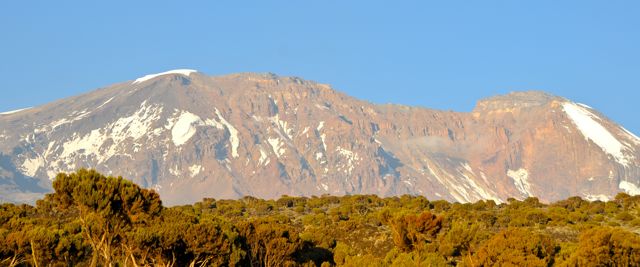
Day 2: View of the summit from Shira Camp (3,840m/12,600ft)
We had departed base camp at midnight on Day 6, estimating our arrival at the summit around sunrise. I was having a hard time the first hour and felt exasperated knowing I had at least another six hours of climbing to go. My mind lacked focus as a result of the chaos that had just occurred back at camp.
We had been encouraged to rest that evening in preparation for the long and challenging summit climb. But no rest came to our tent. Thomas, who had been battling illness since the first day of climbing, seemed to worsen in condition. He had had a rough time on the mountain, beginning with a bad case of the runs in the rain forest on Day 1. We had many adventures at the “toilet” that first night at camp, where I found poor Tom puking on his boots as he squatted over a hole. Being the great girlfriend I am, I naturally cleaned his boots, and insisted that he start taking antibiotics. When the guides learned of his condition, they instructed him to stop taking the drug Diamox (which helps one acclimate) but also has side effects of diarrhea. We had thought he was getting better until the fever arrived on Day 3, the same day we reached the base of Lava Tower at 4600meters/14,900 feet, which I suspect was the beginning of his altitude sickness.
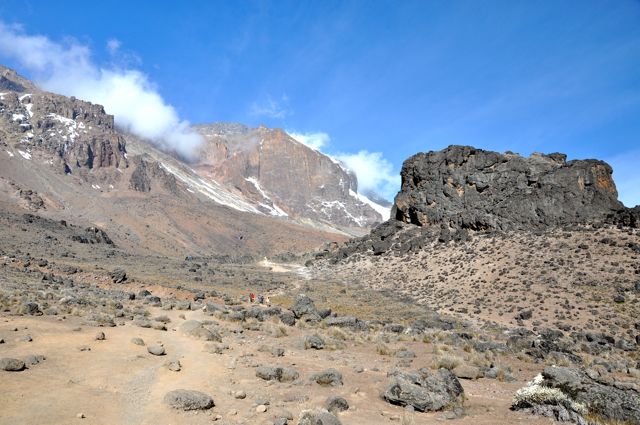
Lava Tower (4,550m/14,900ft)
An hour before our scheduled departure for the summit, Tom still had a temperature of 100-degrees. I rested my head on his chest I noted his rapid heartbeat and irregular breathing.
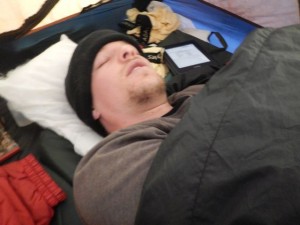 “My lungs hurt when I breathe. I can’t get enough air,” he said coughing violently.
“My lungs hurt when I breathe. I can’t get enough air,” he said coughing violently.
I could tell he was in pain, his eyes glazed with sickness and worry, his face pale.
“Listen to this,” he said exhaling deeply. A gurgling sound followed.
“Well that is not good at all,” I said, stroking his chest. I tried to appear calm but my concern was mounting by the minute.
I quickly exited our tent and woke Antipas, the head guide.
“Tom is not okay. There is fluid in his lungs and I believe he is suffering from High Altitude Pulmonary Edema (HAPE) or pneumonia,” I explained feeling out of breath from my short walk to his tent.
Antipas accessed Tom’s condition agreeing that it was imperative that Tom get to lower elevation immediately.
The others in our group were gearing up to depart for the summit but I felt frozen. Tom insisted that I continue my climb. We had agreed before we began climbing that if one of us couldn’t make it to the top, the other should keep going so long as the other was not in critical condition or unable to speak for themselves.
“Tom will be fine, I will take care of him. You came to summit this mountain. Don’t disappoint me.” Antipas said in all seriousness.
I frantically helped Tom pack his rucksack and split the contents of our medical kit, unsure of when I would next see him. I mixed hydration powder with two liters of water and made him promise me he would drink it all.
“Make it to the top for me sweets” he had said with a kiss goodbye. I hugged him for a long time, feeling very uneasy.
There were only three of us left … me, Jenn and Karen. Older Tom (Tom A) a recently retired American had decided to descend the mountain on Day 4. He is a sweetheart, and I was impressed that at the age of 68 he tried his best to tackle Kili. I had learned a great deal about each of them during our climb together.
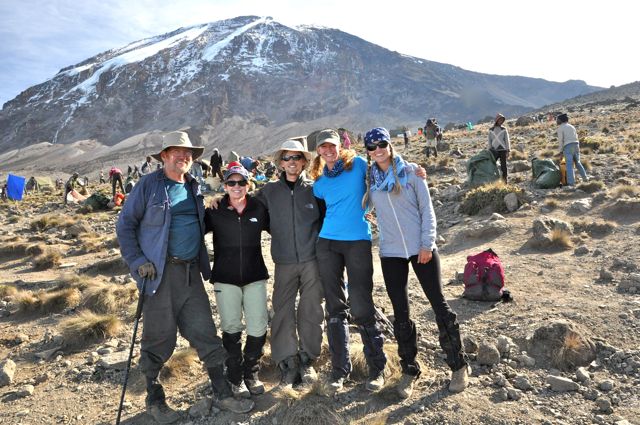
The whole gang, the morning of Day 4
Karen, a spunky, loud, dental hygienist from Philadelphia seemed to have failed geography class. I was embarrassed for her and my country, when she realized at the age of 55, Africa is a continent, not a country. A staunch Republican, I would come to realize, deciding it was best I keep my liberal opinions to myself. I lacked energy to breath and walk on Kili and certainly had no strength for a political debate!
Jenn, a very pretty girl, put on blush each morning . As a teacher it is her job to correct others and always know the answers. And as it is with many Canadian’s I have met on the road … she is extremely patriotic and sensitive to be mistaken as an American (but was still thrilled when Target and Starbucks arrived in her hometown). I very much commend Jenn for traveling to Tanzania on her own. That takes guts, I give her a gold star!
Dennis the jovial assistant guide was the leader of our pack. Barak, the sweet cook, brought up the rear, I presumed to catch us if we fell backwards.
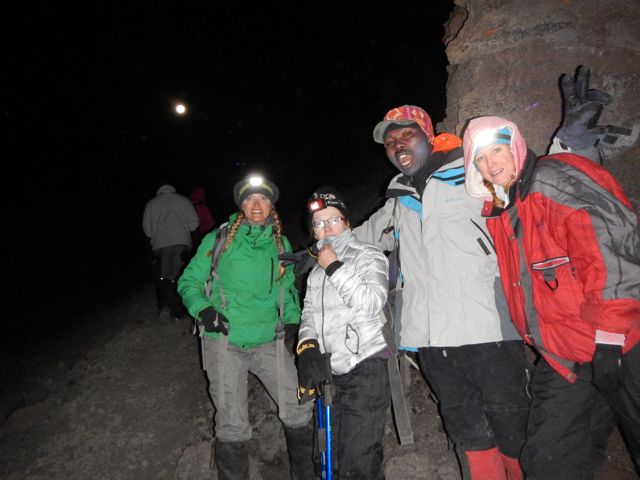
Day 6: Beginning of the summit climb, not looking so good
We climbed pole pole (meaning slowly slowly in Swahili) in silence though the darkness. A full moon shined brightly but headlamps were still needed to navigate the steep rocky terrain.
My mind was all over the place, I worried about Tom. Would he be okay? Was I a terrible girlfriend for continuing without him? How would he make it down the mountain? Would they carry him on a stretcher? Would he be taken to the hospital? I knew it was imperative that I gain focus on the mission at hand, making it to the top, but it was extremely hard to do.
Dennis had warned us to “never look up, or risk becoming discouraged,” but my curiosity made me do it anyway. I was horrified to see a band of tiny white lights way off in the higher distance. We had a very long way to go, making it to the top didn’t feel possible at that moment.
I resorted to looking at the ground and the back of Jenn’s legs as this is all I could see.
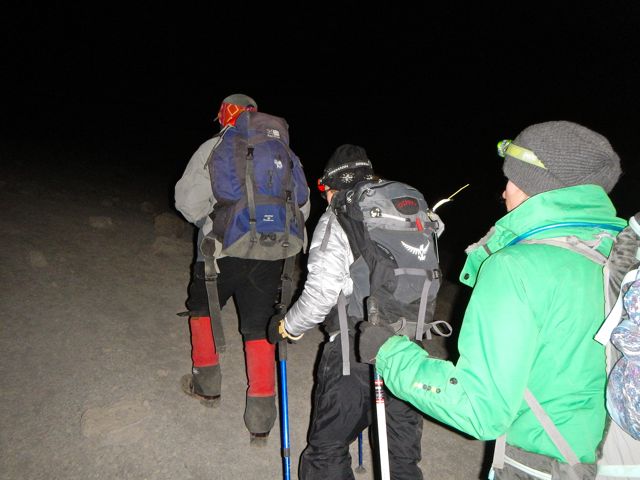
Climbing through the darkness to the summit
Feeling weak I pulled out a coconut chocolate chip Cliff bar, even though I had no appetite. I found it impossible to chew and breath at the same time. I had to stop and sit in order to finish the bar, causing Karen to curse as she tried to pause on the steep incline, her poles unable to hold firmly to the rock.
Early into the climb my 3L Camelbak froze. I had tried to blow back into the hose to prevent it from happening, but the energy required left me feeling light headed. I was left with only a 1-liter bottle of water for the remainder of the night.
The temperature outside was freezing, –10 degrees Celsius. Aside from my face and fingers I felt surprisingly warm. Knowing my intolerance for the cold, I opted to wear an absurd amount of clothes … twelve tops and five bottoms. I also attached heat-warming patches to my back and stomach and inserted hand warming packs inside my shoes. Karen joked that you could bbq on me.
A couple hours into the climb the dreaded happened. I had to pee badly. I was having a love hate relationship with the drug Diamox, feeling it was helping me to acclimate but causing me to have to urinate twenty plus times a day which was super annoying and inconvenient on the mountain.
I searched for a “toilet” in the darkness, privacy being hard to find with over 200 people on the same path. I crouched behind a small rock struggling to pull down my five pants, the effort of which left me breathless. When I pulled my pants back up I managed to scoop up a pile of rocks into my underwear. Too tired to care, I walked on as stones dropped through my pants legs. I considered the benefits of adult diapers for such an occasion.
I noticed Jen was listening to her ipod. That was smart I thought, an iPod would have been a great distraction and way to keep my mind focused. Instead it was just me and my thoughts. I had a few mantras I repeated over and over in my head …
“I can do this”
“Left, right, left”
“Go higher and higher”
“Just walk”
“The top is near”
“Just do it”
It was very tough to stay focused and positive. I solemnly marched on.
I began to feel strange, nauseous … a dull ache was growing in the back of my head and I felt dizzy from the constant switchback and darkness. I felt like a zombie, somehow detached from my body. My legs didn’t feel like my legs anymore, but thick heavy logs that I could barely control.
Paranoia started creeping in, which I feared would happen. Tom had told me he worried my determination would cause me to ignore signs of altitude sickness. I assured him he need not worry and I was more likely in this situation to run screaming down the mountain fearful of dying of cerebral edema.
I had to remind myself that mild altitude sickness is normal at such a high elevation, after all I was at over 19,000 feet high and was only breathing in half the oxygen I would at sea level! It made me feel better to inform the others of how I was feeling. Dennis told me to stop worrying so much, I was going to be just fine.
I continued to climb higher.
I did not have a watch and we were forbidden to ask “how high are we?” or “how much longer?” so I lacked any concept of time. All I knew is that the night seemed never ending and the darkness felt heavy and weighed on my spirit.
I told Dennis I wanted to rest, he responded “we will stop soon.” But soon was never soon enough.
When we did stop to rest, I felt as if I seriously might fall asleep sitting straight up. I rubbed my eyes and slapped my face lightly a few times. I felt delirius. We were never allowed to rest for very long, for fear we would loose momentum and become cold.
It must have been only halfway through the climb that I decided I was in a freezing hell. While I absolutely loved the first five days of the climb, I hated every minute of the final summit climb. I even told myself “never again” at some point. I was confident I wouldn’t have felt so miserable if I were climbing in the light of day and could appreciate all the beauty around me. Climbing in the dark totally sucked.
Why the hell are we climbing in the dark? I wondered and remembered the three reasons Antipas had given …
1. So you can’t see how far you have to go
2. To make it to the top at sunrise
3. Because you have to climb down after
The latter reason was one that I could not contemplate at the moment. The thought of having to climb 8-9 hours down the mountain after I reached the top seemed like a torturous nightmare. I had asked Antipas if perhaps I could slide down on my sleeping mattress and he did not find this idea amusing at all.
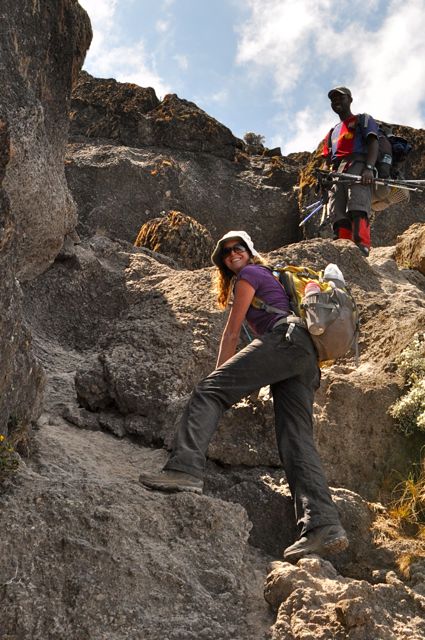 I climbed on in denial, noting that sunsets are way better than sunrises as far as I was concerned.
I climbed on in denial, noting that sunsets are way better than sunrises as far as I was concerned.
Every so often someone would pass us on the way down the mountain. They were usually in tears, which I could understand. It would be devastating to have to turn around having come that far.
“You aren’t turning around.” I told myself. “Don’t even think about it, it’s not happening, just walk.”
But I kept thinking, and I often asked myself “Why are you doing this again?” “Who’s idea was this?”
It was my idea of course. I just woke up one day and decided that I wanted to climb a mountain, for the challenge of it. I had never climbed a mountain nor had I ever hiked for more than one day at a time. I figured if I was going to climb a mountain it should be a really big one. I wanted to visit east Africa so Kili fit the part. I had considered climbing Mount Kenya for a short while, Africa’s second tallest mountain, which was much cheaper to climb and less touristy. Upon further research, I learned that I would only be able to reach the third highest peak as the second and first required skilled technical climbing with ropes. Climbing to the third highest peak of Africa’s second highest mountain, seemed totally lame, and I quickly set my mind on Kili.
I had chosen the Machame Route (also known as the “Whisky Route” being quite difficult) because it was the most scenic and offered the highest rate of success to the summit which is attributed to the routes course that has you climb high and sleep low with more time to acclimate.
The route was absolutely fantastic and I thoroughly enjoyed the first five days. Each day offered a different terrain and challenge. We had ascended through multiple ecosystems passing rainforests, and alpine deserts. In theory you could march right up to the top of the mountain, but it is important to allow your body the time to acclimate, and this route allows you time to hike around at lower elevations (but still quite high) before summiting. I would recommend doing the route over the course of 7 days versus 6 (costs a bit more but totally worth it as you allow your body more time to rest.)
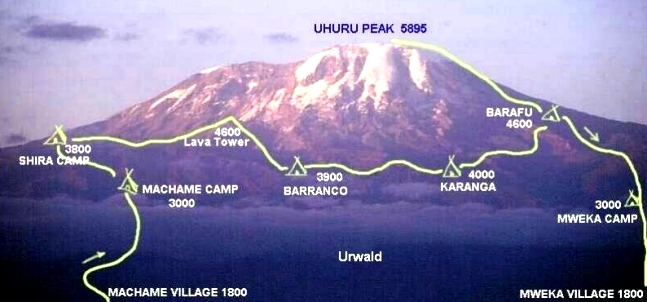
Machame Route Map
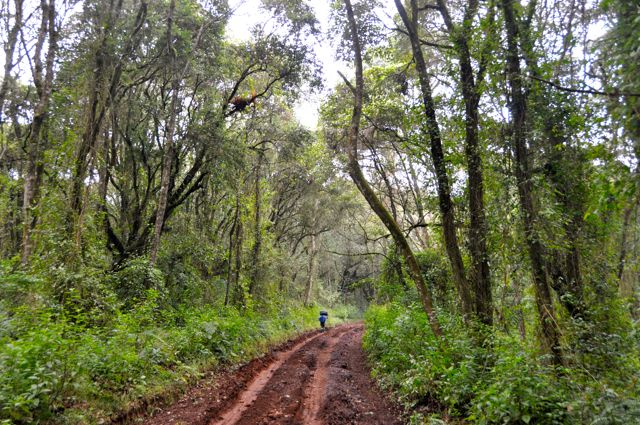
Day 1 in the rainforest
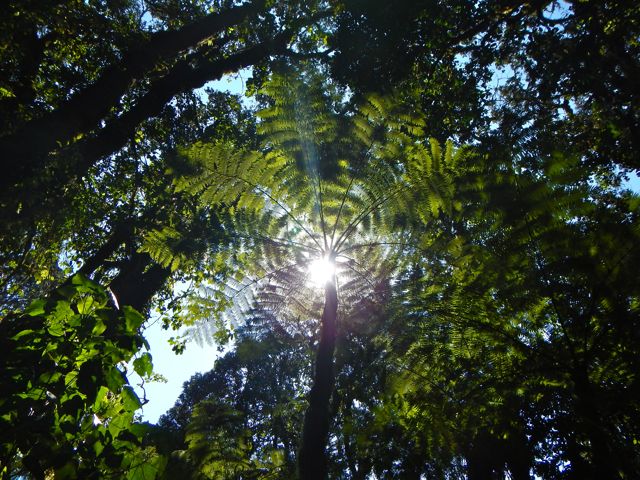
Day 1: Into the rainforest
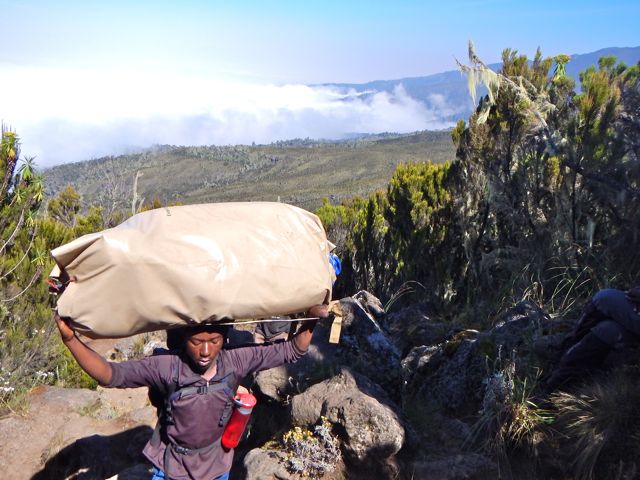
Day 2 Picnic Rock
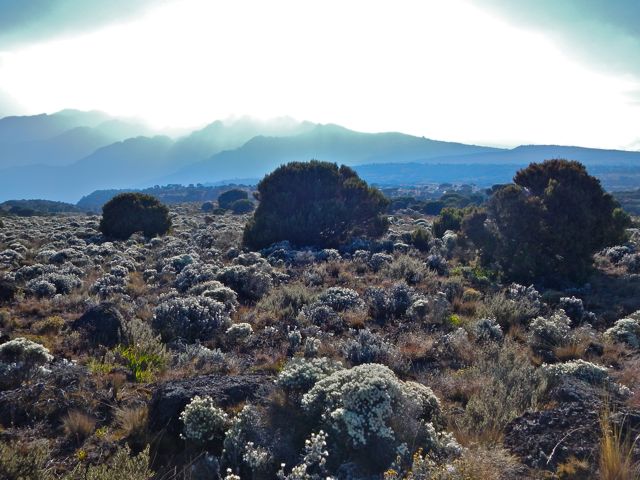
Day 2 – Shira plateau
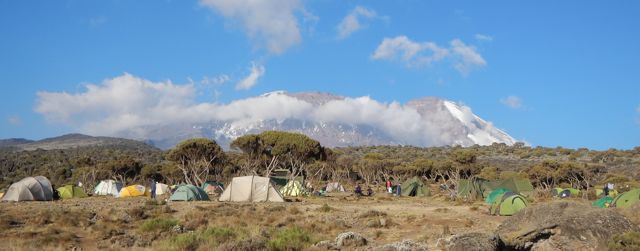
Day 2: Shira Camp (3,840m/12,600ft)

Day 2: Sunset Shira Camp (3,840m/12,600ft)
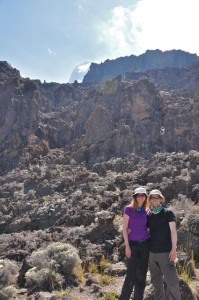
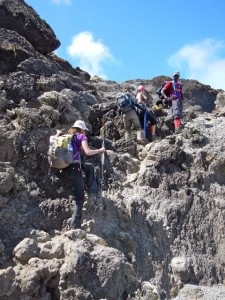 I had heard before I climbed that Kili was just a long walk, but I would absolutely disagree, as the Machame route had many technical parts. I have heard that the Marangu Route (it’s nickname the “Coca Cola route” turned me off immediately) is said to be the easiest route up; however, has a much lower success rate to the summit because of challenges acclimating on this route.
I had heard before I climbed that Kili was just a long walk, but I would absolutely disagree, as the Machame route had many technical parts. I have heard that the Marangu Route (it’s nickname the “Coca Cola route” turned me off immediately) is said to be the easiest route up; however, has a much lower success rate to the summit because of challenges acclimating on this route.
The Machame climb was very steep and rocky often, and often we had to abandon our walking poles and use both hands to climb up steep rock walls. The first three hours of Day four involved climb up the Barranco Wall, a scramble of sorts that requires you to literally hug the mountain at times and would not be advised for anyone scared of heights (Spencer don’t even think about it! 😉 I found the challenge fun, but the number of other climbers and porters on the trail was a bit nerve racking at times.

Day 4: Baranco Wall

Day 2: climbing the Baranco Wall
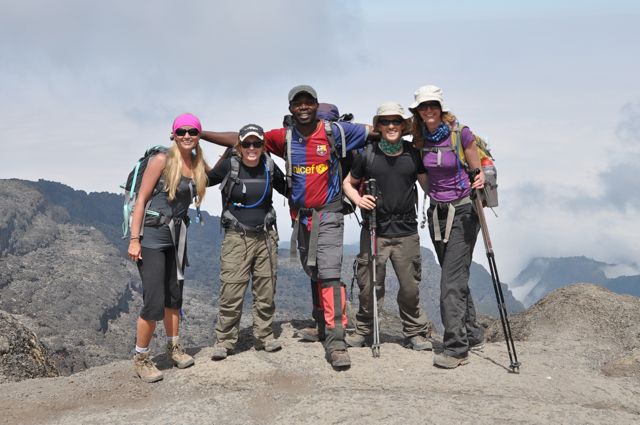
Day 4: top of the Baranco wall
The views were outstanding in every direction, the tip of Mount Meru was always poking through a thick blanket of clouds that stretched endlessly into the distance.
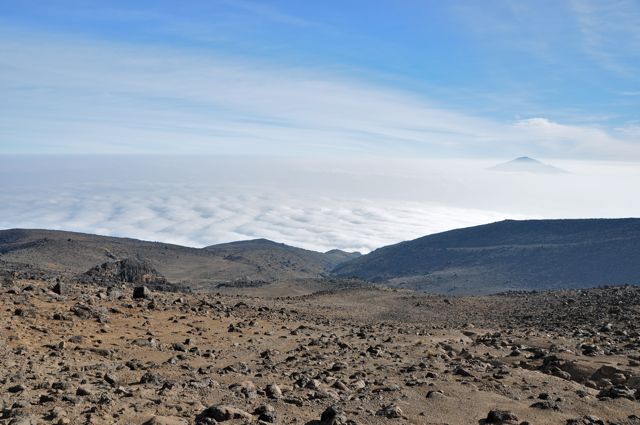
Mount Meru in the clouds
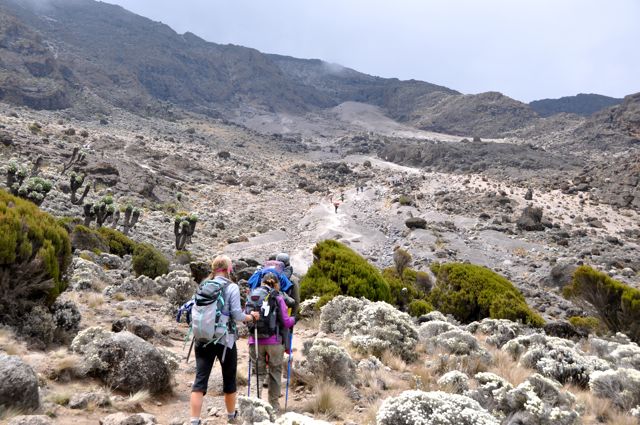
Day 4: descending into the Karranga Valley
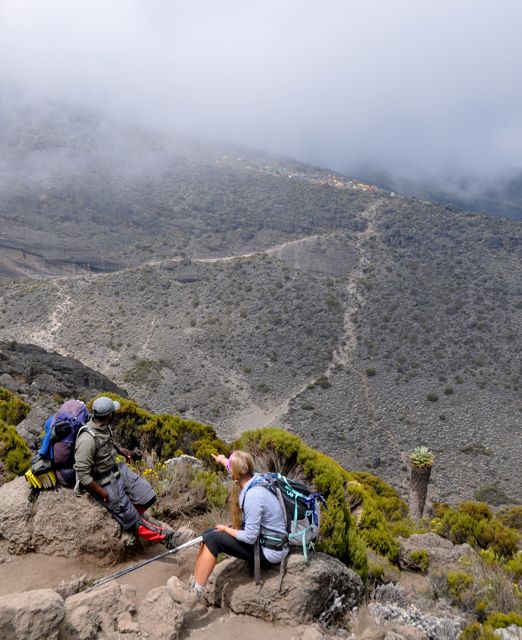
Day 4: Karranga Camp in the distance – (3,950m/13,000ft)
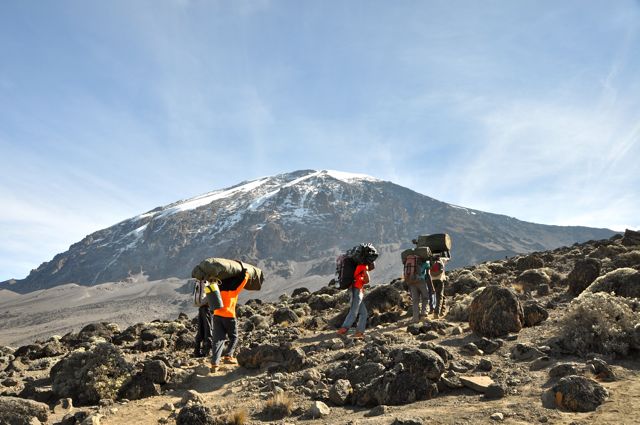
Day 5: amazing porters
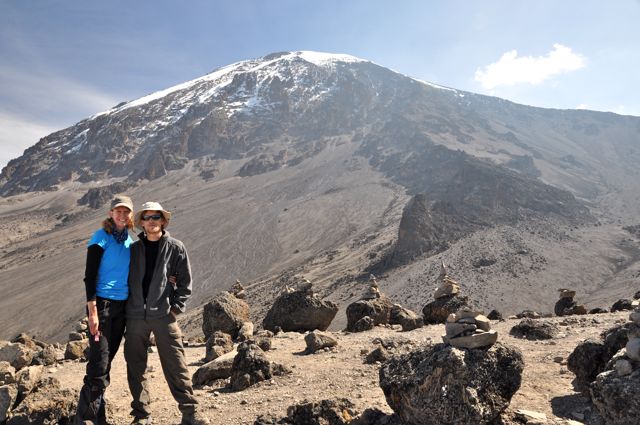
Day 5: Kili’s summit in clear view
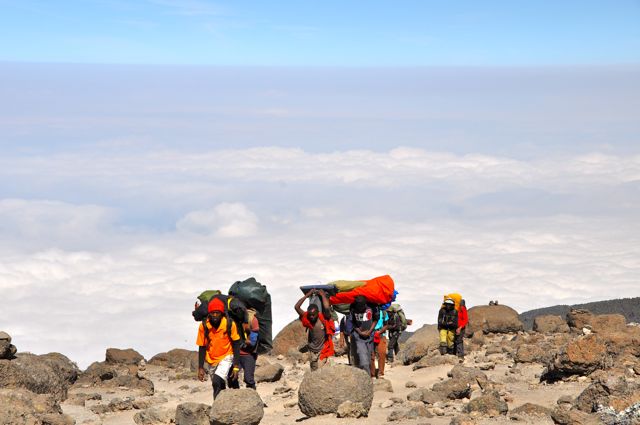
Day 5: porters high above the clouds
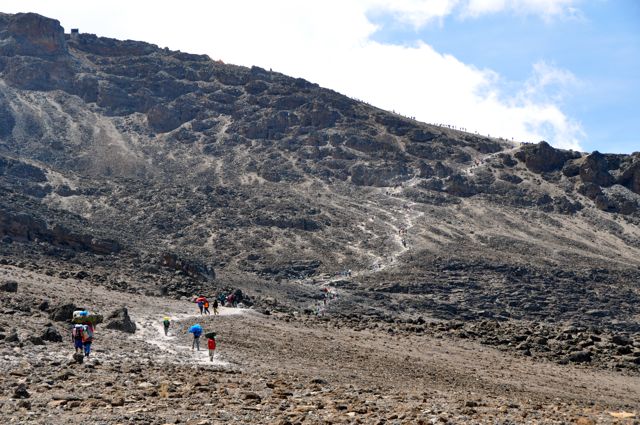
Day 5: final climb to Barafu camp (aka BASE Camp)
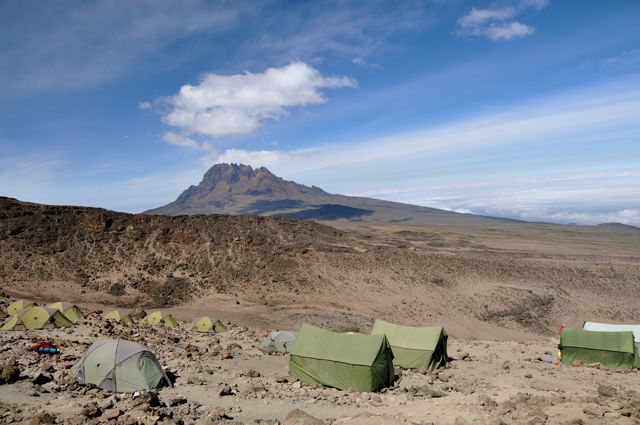
Day 5: Barafu Camp ((4,600m/15,100ft)) aka as BASE Camp
Throughout the climb I had surprised myself, being more physically fit than I had thought. I expected to awake with sore muscles each day, but I felt really good and excited to climb further … except for the summit night. My Soloman boots performed wonderfully, giving me no blisters. My shoulders did ache the first few days from carrying my heavy daypack weighing close to 20 pounds, but by Day 3 I had grown use to it.
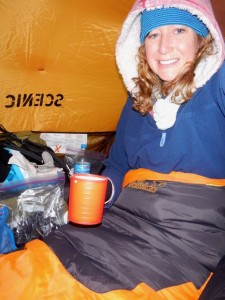 The tour company, African Scenic Safari had taken excellent care of us (btw it is not possible to climb Kili solo, you must hire a tour company and I highly recommend this one). I twisted my knee on Day 3 when I jumped off a rock to race behind a big bush to pee. Dennis had someone climb and cut a slap of ice off the mountain face to ensure my knee didn’t swell.
The tour company, African Scenic Safari had taken excellent care of us (btw it is not possible to climb Kili solo, you must hire a tour company and I highly recommend this one). I twisted my knee on Day 3 when I jumped off a rock to race behind a big bush to pee. Dennis had someone climb and cut a slap of ice off the mountain face to ensure my knee didn’t swell.
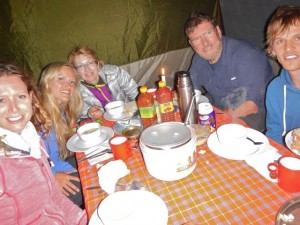 When we arrived at a new camp we were served popcorn, cookies and tea. I credit Jenn for teaching me to dip my popcorn in chili sauce, so much better! The cook, Barak, made us delicious warm meals for breakfast and dinner, and gave us a box lunch each morning to carry with us on the trail. We were fed very well, dinner usually consisting of a soup, bread, tomato and cucumber salad, fish or meat, vegetables, and fruit for dessert. (It is still advised to supplement your meals with 2-3 protein bars per day.)
When we arrived at a new camp we were served popcorn, cookies and tea. I credit Jenn for teaching me to dip my popcorn in chili sauce, so much better! The cook, Barak, made us delicious warm meals for breakfast and dinner, and gave us a box lunch each morning to carry with us on the trail. We were fed very well, dinner usually consisting of a soup, bread, tomato and cucumber salad, fish or meat, vegetables, and fruit for dessert. (It is still advised to supplement your meals with 2-3 protein bars per day.)
Being nothing close to a morning person, I absolutely hated being woke up at 6 am every morning, but I did appreciate that Barak also brought me hot coffee into my tent.
Each evening before dinner and every morning before breakfast we were brought a bowl of hot water to “wash up”. As it was below freezing as soon as the sun went down, the once parts of me that got washed were my feet and hands. Baby wipes came in handy for the rest of the body, but I was fine with and accepted being dirty and dusty for the entire week. There are no showers on Kili just in case you wondered.
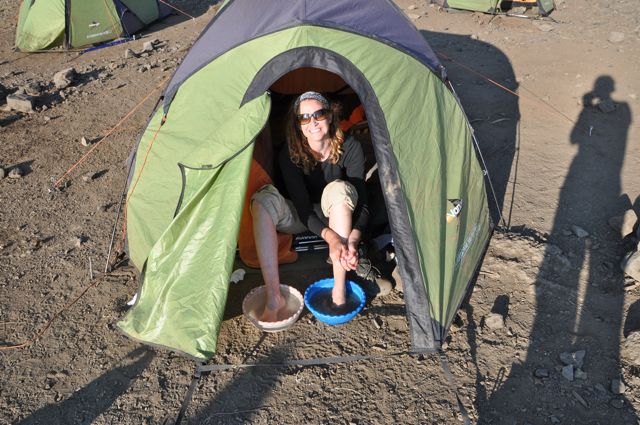
Washing up
And the toilets were just amazing (I plan to write and entire post on this subject.)

Very inviting toilet
At some point during the summit night I just surrendered. I stopped worrying and my mind went blank. I walked in a sort of trance state.
Then to my surprise it started happening. Out of the corner of my eye I saw a faint pink glow. Was that the sun?!? It was indeed! HOORAY! I would have jumped for joy had I the energy, and shockingly I also didn’t have the strength to pull my small camera out of my jacket pocket to take a photo at that moment. I knew this meant we had to be close. The world began to open up and I saw we were surrounded by snow.
The sun lifted my spirits and with the top within my sight, I knew at that moment that I really was going to do this thing I had set out to do. I would indeed summit Kilimanjaro!
We reached Stella point ( 5,750m ) at 6:15 am, Karen fell to the ground believing she was at the summit. I knew better, that Stella point was a mere teaser with a sign, and we still had another hour until we would reach the highest peak of the mountain, Uhuru.

Sunrise Stella Point 6:15 am Day 6
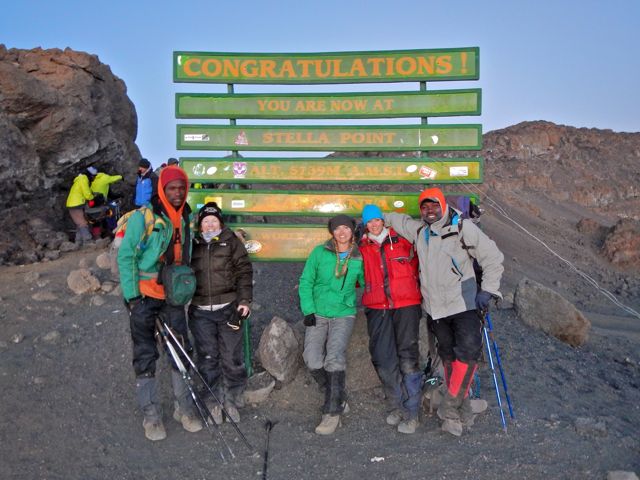
Stella Point (5750m/18865ft)
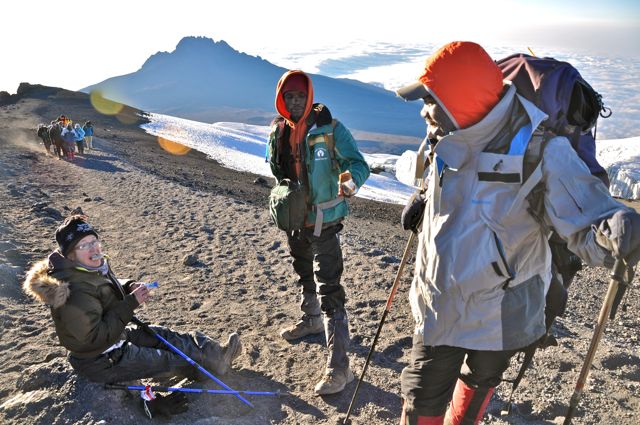
Day 6: At Stella Point 6:15 am
To the right was the crater rim, to the left were the glaciers, both of which were more massive than I had expected. A truly remarkable sight.

Crater Rim on the top of Kilimanjaro
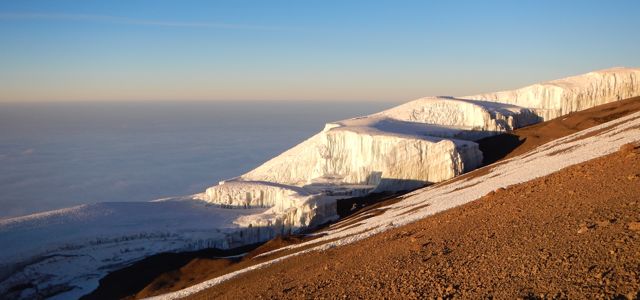
Sunrise on the glacier
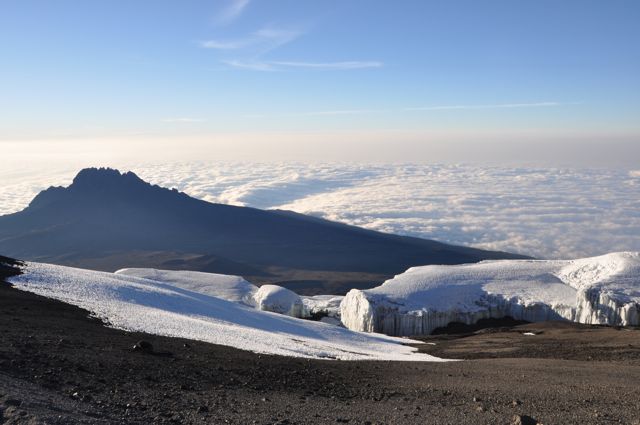
Summit of Kilimanjaro, Mount Mawenzi in the distance
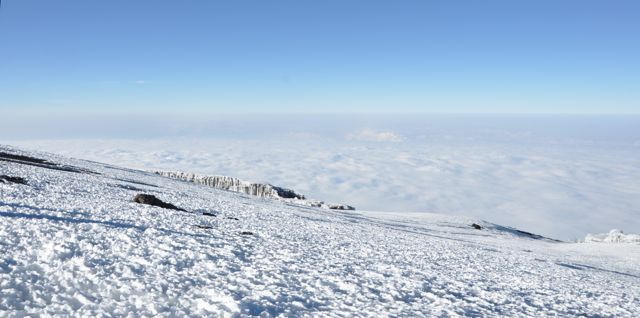
Top of Kilimanjaro (5,895m/19,340ft)
The sun had risen fully making the last push to the Uhuru peak more enjoyable.

Kili’s glaciers such a remarkable site!
I could see the green sign distance, crowds standing awaiting their turn for the prized photo to share with their friends and family. I am sure many people were uploading the pic on Facebook real time as there is cell reception on the summit, but I think such behavior is super lame. Be present in the moment people, soak it all in, Facebook later!
As I stood at the top of Africa’s highest mountain and the world’s highest free standing mountain …. (5,895m/19,340ft), I felt triumphant!
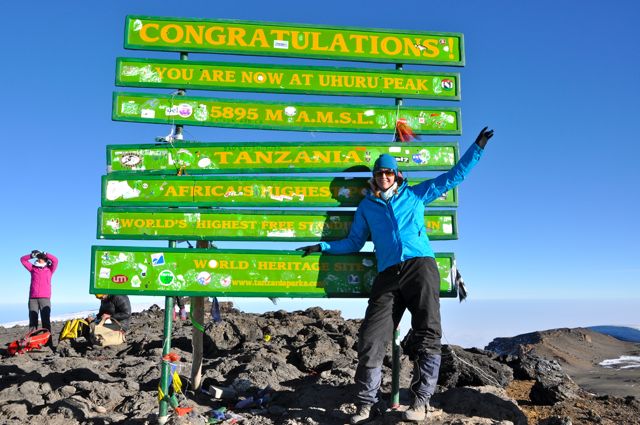
At the summit of Kilimanjaro – Uhuru Peak (5,895m/19,340ft)
The overwhelming feeling I had while standing on the summit was one of relief. I was relieved that I could still do that which I set my mind to no matter how hard the challenge. I had doubted myself at times during the night and I felt a renewed confidence in myself.
Whatever the mind can conceive and believe, the body can achieve. – Napoleon Hill
Climbing Kilimanjaro was definitely more of a mental than physical challenge for me. The high altitude affected me psychologically, my mood shifted, I was grumpy, ill, and was eager to descend. It seemed strange to me that I wasn’t compelled to skip and frolic on the summit in complete bliss after how hard I had worked to get there. But instead I was content with taking a few photos and wanted to get the hell off the summit ASAP, as I worried about the consequences of lingering too long at such a height.
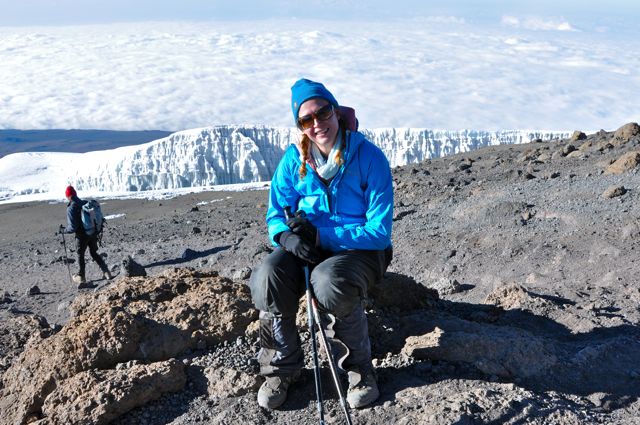
Exhausted on the summit
On our way we passed many that were still climbing to the top. They could best be described as the walking dead. I knew I must look dead too.
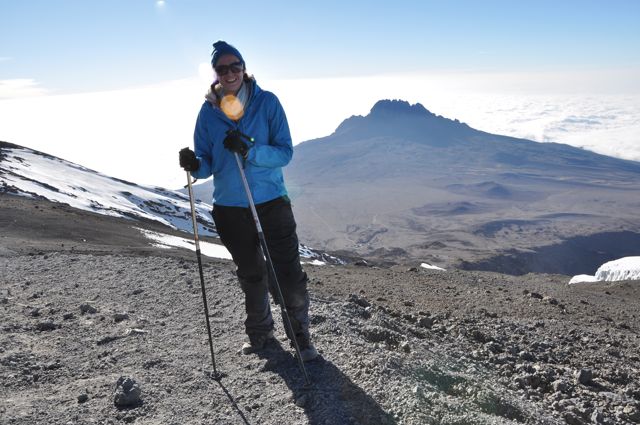
Day 6: ready to descend!
In the light of day it was amazing for me to finally see the path in which I had climbed all night. I felt proud of myself.
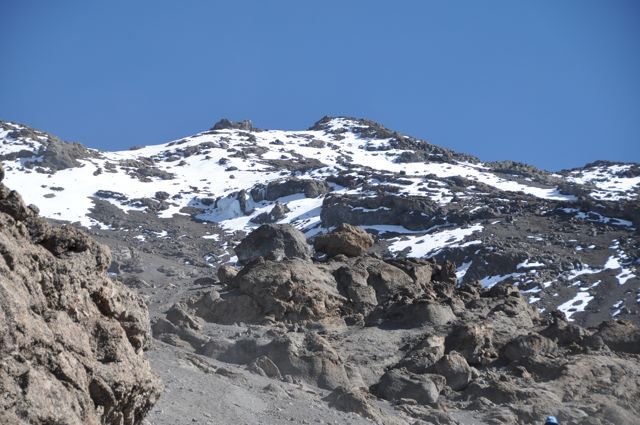
Heading back down Kili
After a slow descent past the steepest parts of the peak we reached an area of the mountain covered with loose sandy volcanic ash soil (called scree) that was so difficult to climb up during the night. Barak demonstrated the technique of “scree running” which basically involved digging your heals into the loose ground and slide as if you were skiing down the mountain, at a very fast speed at that. Being a very clumsy person, I feared screeing at first, but gave it a go welcoming any opportunity to get back to camp more quickly so I could sleep. I found screeing quite fun, minus the dust intake caused by those screeing in front of you.
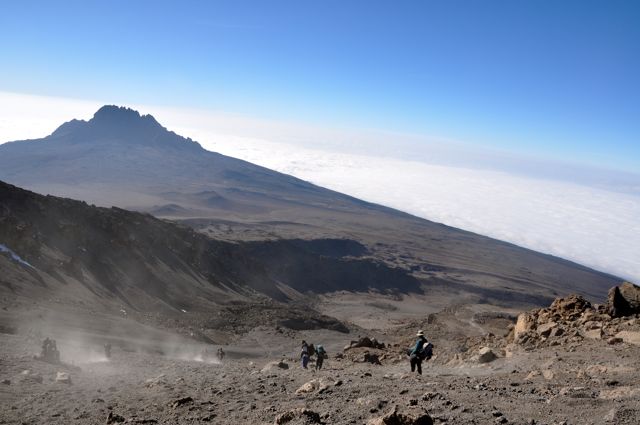
“Screeing” down the mountain
The temperature rose quickly with the sun and I had to stop many times to peel off another layer. “ANOTHER!?” Barak would ask in amazement at the amount of clothes I wore. Each layer was completely drenched in sweat including my pants. I had no idea my legs could sweat so much.
It took us 2 hours to reach base camp, astonishing considering it took us 7 hours to go up the same path!
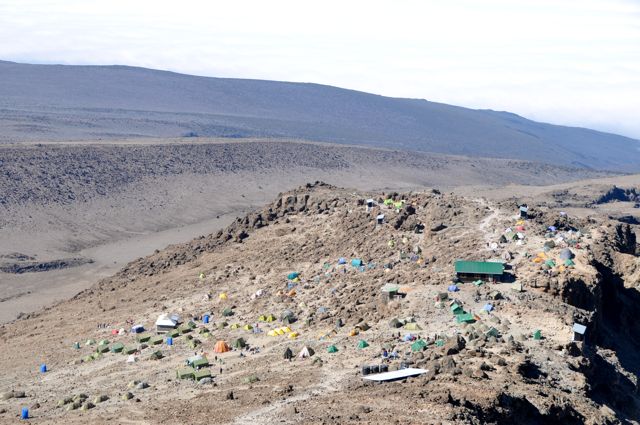
Base camp (4,600m/15,100ft)
At base camp I was greeted with a cheer of congratulatory high fives and a glass or orange juice which I chugged. I fell into Jenn’s tent and passed out instantaneously. We were only permitted to rest one hour before we were woken for lunch.
I moaned as we began our 6-hour descent to the next camp in which we would stay for the night. Did they want to kill me I wondered? I did the calculation that I would be climbing a total of 15 hours in one day having not slept in 36 hours. Who’s brilliant idea was this? All I wanted to do was sleep forever.
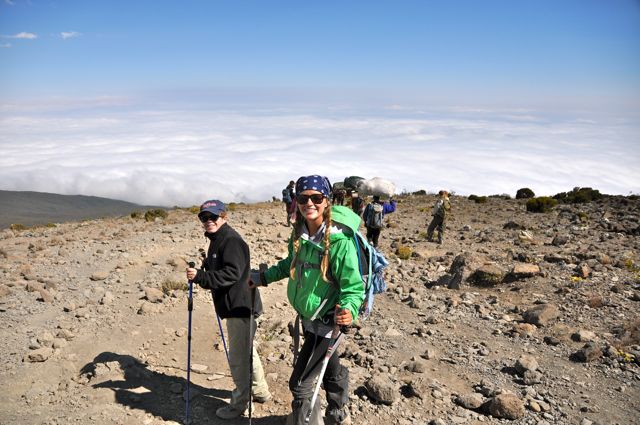
Day 6: Heading down the mountain
But there was no choice so we grudgingly hiked on, our knees aching all the way down.
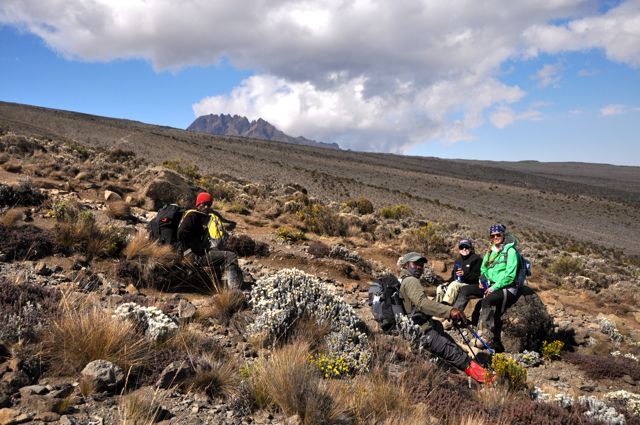
Day 6: the way down
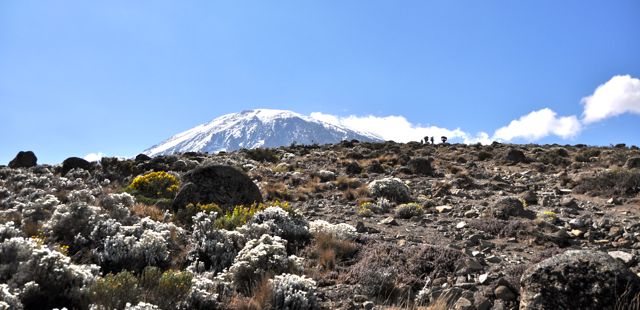
Day 6: Descending, looking back on the summit
Dennis received a text from Antipas that Tom was feeling better. We didn’t know exactly what that mean and I was surprised when he greeted me at our camp at Mweka Hut.
“You did it!” he exclaimed with a big smile, hugging me tightly. “I am so proud of you!”
We were now at 3100m (10,170 feet) and Tom felt he could breath more easy; however, that strange gurgling sound still followed his exhale. * He didn’t look well though and he agreed that we should go straight to the hospital the following day once we arrived back at town.
We were camping in the rain forest, our tent set up by the porters under a cozy canopy of trees.
“Let’s go to sleep darling” Tom said.
As I lay my head on the soft ground, I finally smiled. I DID IT!
I slept like a baby that last night on the mountain, dreaming of a hot shower, a warm bed, and a clean toilet seat.
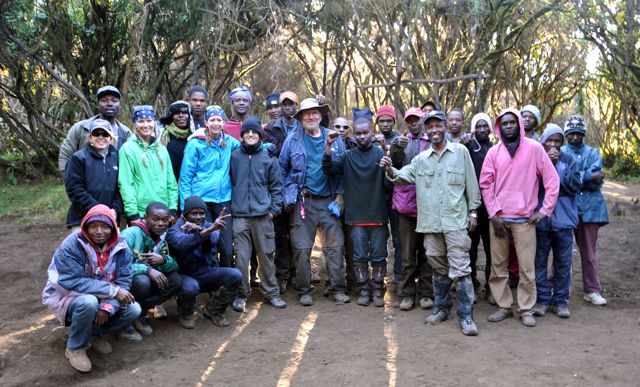
African Scenic Safari Crew
* The following morning we hiked three hours to the end of the trail. We were driven back to Moshi town and went straight to a medical clinic. Blood and urine tests confirmed Tom had an infection in his body; however, the clinic was not equipped with an x-ray machine to confirm whether or not he pneumonia or altitude sickness. I vigilantly watched over the doctors ensuring that all needles were sterile out of a package. Since doctors couldn’t confirm his condition they treated him for all possible illnesses. He was given antibiotics for pneumonia and an IV in his hand to treat High Altitude Pulmonary Edema. Tom was quite traumatized by his trip to the hospital, but has since recovered fully.
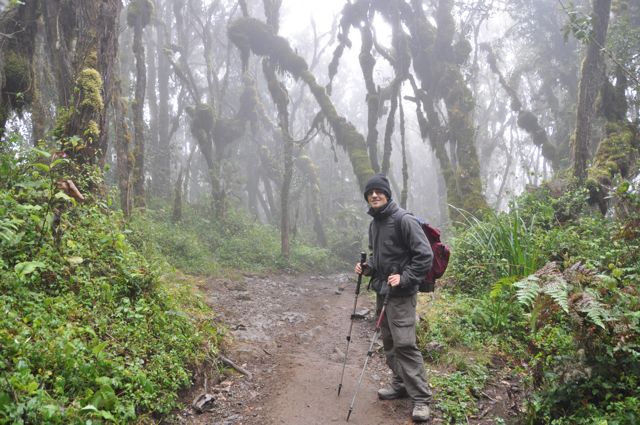
Day 7: Last climb down the mountain
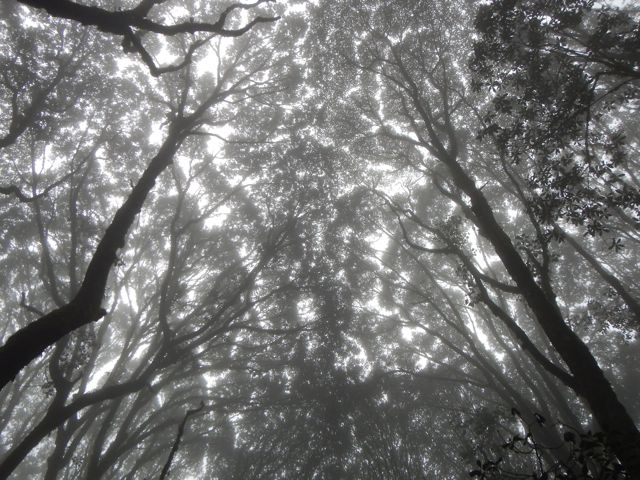
Day 7: cool canopy
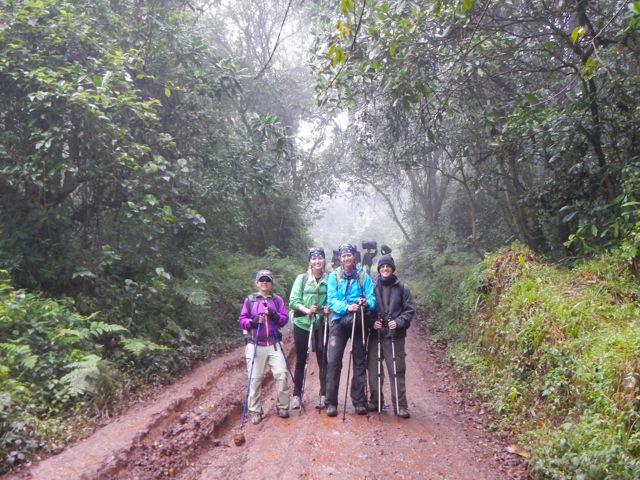
Day 7: the end of climbing Kili!

My boots after 7 days on the mountain
VIDEO of the African Scenic Safari Crew bidding us farewell with their song.
To see all of my photos from my climb up and down Kilimanjaro CLICK HERE!
Tags: Africa, challenge, climbing, hiking, Kilimanjaro, mental challenge, mind, mountains, Tanzania









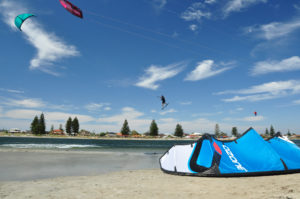

4 Comments
Wow! Kelly-what an accomplishment and something to be so proud of..I can finally say I really do know someone who climbed Kilimanjaro!..thanks for sharing..can’t wait to read your book!
Thanks Barbara! 🙂
Truly awesome, inspiring
I know you could do it too BF, such a cute little goat! 🙂